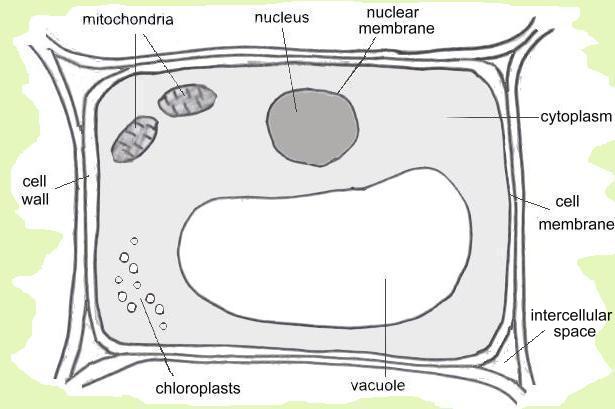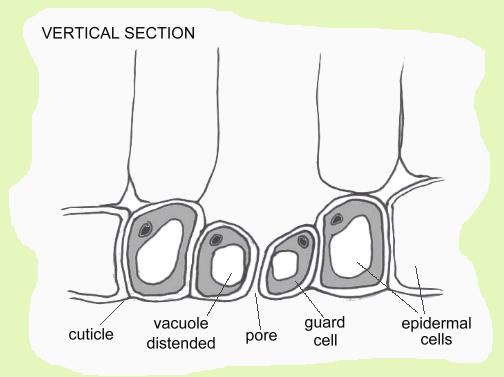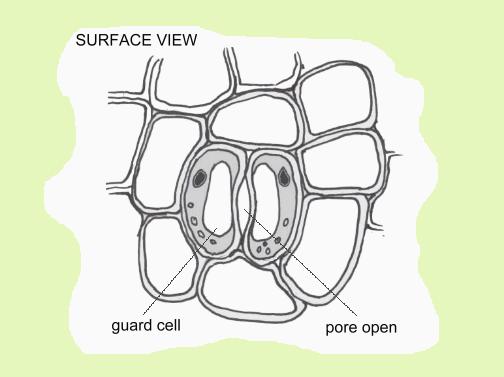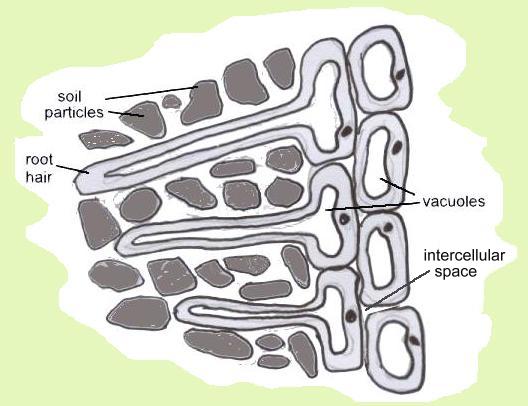Due to the unique properties of the water molecule, life as we know it would not be possible. In space exploration it is the 'Holy Grail' and any hint of its presence on a planetary body causes a wave of excitement in the scientific world. However as the exploration of the solar system continues, it is now known that water is present on many of the planets and their moons.
It not only provides the medium in which life exists, but it is involved chemically in some metabolic pathways, eg. providing Hydrogen during photosynthesis. Plants also use water for support. Most animals have a skeleton - either external or internal, to support their bodies. Plant tissue relies on water pressure with a support structure in the form of a cell wall. In most plant cells a vacuole which contains mainly water acts like a fluid-filled balloon to push outwardly, keeping the cell turgid. If the pressure is lost due to a lack of water the cells become flaccid and the plant wilts. In woody stems the cells which are holding the plant upright are mostly dead so the vacuole is absent and a rigid cell wall reinforced with lignin remains to provide the support, eg. the heart-wood of a tree.
The transfer of water into and out of cells is by a process called osmosis. This works across a concentration gradient where water moves from a dilute solution of salts and sugars through a semi-permeable membrane to a solution with a higher concentration. Plant cells contain salts and sugars in a higher concentration than their surroundings so water is drawn in - the cell membrane and the cytoplasm within the cell act as the semi-permeable membrane. On the fine roots the outer cells have very thin walls and elongated projections or root hairs which sit between the soil particles. The vacuole extends into the root hair and contains the higher concentration of salts to draw in the water.
The symbiotic mycorrhizal fungi which are found in asociation with most plants extend the reach of the roots so they increase the amount of water the plant can take up.

A diagrammatic plant cell showing some of its contents.
Water flows through a plant carrying nutrients upwards from the soil and after photosynthesis, it carries the products back around the plant for direct use or storage. This takes place in a vascular system made up of the xylem and phloem in the stems and leaf veins. The xylem vessels take water from the roots to the leaves and the phloem moves some of it containing sugars back in the opposite direction. Most of the water which travels upwards is lost from the leaves through pores called stomata - a process called transpiration. It is this loss that creates the negative pressure to move the water upwards, as atmospheric pressure alone could not force it to the top of a tall tree, which can lose many hundreds of litres per day - this is called the transpiration stream. As a water molecule is lost through a stoma, it is replaced at the root by another molecule and the column of water moves up the stem.
Water also accumulates in the cell wall and spaces between cells - the inter-cellular spaces, called the apoplast. This is were most water movement takes place since the movement through cells is relatively slow and the flow rate of the transpiration stream can be up to 45 metres per hour. When a stem is cut the water continues to rise and air is drawn in, so the column is broken and it dies. The theoretical maximum height that the column of water can reach as gravity stops it going higher, is 130 metres so the tallest tree will never be greater than this. To date a Redwood (Sequoia sempervirens) called Hyperion, is 115.7 metres tall (379.7 feet) - growing in Redwood National Park, California.
The higher the concentration of carbon dioxide in the atmosphere, the fewer the number of stomata on the leaves because they can still get the same amount of carbon. However, with fewer stomata less water is lost so reducing the amount of vapour rising from forests and the cloud cover that forms from it. Also the amount drawn up by transpiration will reduce leaving the ground more saturated which could lead to flooding. So with the increasing levels of CO2 this will be contributing to the effects ofclimate change.
As the water evaporates from the surface of the leaf it takes heat away so it is a cooling system to prevent the temperature rising too high which would cause the cells to stop functioning and the leaf would die. Scorching can occur if droplets remain on the surface in direct sunlight because they act as a magnifying lens to burn the leaf tissues.
Sometimes if a shrub is pruned severely when it is in full leaf and growing well, it can suffer greatly or even die due to the interruption of the transpiration stream. The foliage on the severed branches was drawing the sap along and when it was removed this flow stopped, so buds below the cut which would be expected to sprout, die as well. Some may sprout and grow weakly, but in many instances they don't even start. This is why heavy pruning should be done in the dormant season or if it cannot be avoided, the branches should be thinned out leaving some to draw the sap. When new shoots appear lower down and are growing away strongly, the remaining long branches can be removed. Light pruning or thinning during the growing season should not be to detrimental, but at any time all cuts should be made just above a bud, as anything beyond there will die back and could allow disease to enter.
Large trees extract hundreds of litres of water when transpiring and this can affect clay subsoils, particularly shrinkage in dry weather damaging nearby built structures. Also removing large trees will increase the water content causing it to expand.
As well as allowing water to pass out of the leaves, the stomata are the route for carbon dioxide and oxygen to flow into and out of the plant for photosynthesis. The size of the pore determines the passage of water or gasses and this is controlled by the guard cells which lie side-by-side with the pore between them. The opening and closing occurs when the vacuoles of these cells expand and contract. In daylight the pores remain open due to the build-up of sucrose in the vacuole which holds more water so is turgid and causes the guard cells to form the opening. During the night starch accumulates in the cytoplasm, the vacuoles lose their turgor and the stoma closes. Some plants have a reversed stomatal rhythm and close during the day to cope with desert conditions.
Where the xylem vessels end at the edges of leaves specialised structures called hydathodes can release excess water if there is a high soil-water content and high atmospheric humidity is preventing loss through the stomata. The water oozes out of the hydathodes in the form of small droplets, a process known as guttation. It may be noticed on greenhouse plants which have had copious watering followed by a cool night, the transpiration rate is low and the guttation ensures a good flow of water and nutrients to the plant tissues.


Leaf cells, showing a vertical section and a surface view of a stoma. The vacoules in the guard cells are distended to hold the pore open.

Root hairs extending into the soil.
The loss of water from leaves varies depending on the surrounding environmental conditions so in higher temperatures the loss can be greater. Plants have adapted to these conditions in different ways such as reducing leaf area or having a thick layer of cutin on the surface to act as a sealant. Fine hairs create a microclimate at the surface and reduce the amount of evaporation also preventing winds blowing the water vapour away too quickly. Cutin is derived from fatty acids and is impermeable to water vapour. It forms the cuticle, an outer layer on the cell walls at the surface which makes a seal so that water loss occurs only through the stomata.
The cacti have gone to the extreme of reducing their surface area by not having any leaves and exist as a stout, fleshy stem. They can store all the water they need between periods of rainfall, and usually have sharp spines to protect this valuable resource. Some have a web-like covering to improve the microclimate close to the surface.
Pine trees have evolved to survive a wide range of conditions, in dry heat, at higher altitude and more northerly weather conditions, by having fine needle-like leaves to withstand strong drying winds and they contain a concentrated sap which has anti-freeze properties.
Most garden plants are Mesopyhtes and have relatively 'normal' water relations. The Halophytes have adaptations to deal with high salt concentrations in the surrounding water. Their cells have a higher osmotic potential so that water moves into the cells.
The Xerophytes are adapted to cope with desert conditions and tend to be succulents with fleshy leaves and stems. These are able to hold a large reserve of water and endure drought conditions. Some evade the drought by producing seeds or spores and die away until the returning wet conditions bring them back to life. The Blue-green algae can dry to a crisp mat until wetter conditions return.
Evergreen plants usually have a thick cuticle on their upper leaf surfaces and most of their stomata on the lower surface. The sap also has the same anti-freeze properties of pine trees. They replace their leaves constantly, so lower ones overshadowed from above are dropped and during drought conditions some are shed to reduce the demand for water. Deciduous trees and herbaceous plants lose their leaves and topgrowth during the winter as a way of coping with the freezing and reduced light.
The xylem vessels become less porous as they age and some diseases can block them, so replacing them every year is a good way to keep the sap flowing freely. New vessels are being produced all of the time. They form at different rates throughout the year depending on growth rate of the plant. In woody plants the production of cells slows to a halt in winter creating a ring of smaller, more compact cells - the annular ring. This can also be used to study climate conditions throughout the life of a tree.
A layer of cambium cells lies between the xylem and phloem, these are the undifferentiated cells which divide on the inside to produce new xylem and on the outside to produce new phloem. These cells are also capable of producing roots when layering or taking cuttings.
Some plant diseases cause death by blocking the vascular system, eg. Fireblight and Dutch Elm Disease. Also total removal of the bark causes a delayed death to a tree or shrub as the sugars and starch are unable to reach the roots so they die away and there is no stored starch to send up the trunk later to grow new tissue and leaves. This is sometimes used to reduce the vigour of fruit trees by partially ringing a trunk or branch, but careless mowing around trees and shrubs with a line trimmer can be fatal. This is also why planting too deeply kills a tree or shrub, some which naturally produce suckers are not usually affected, but with most the soil rots the bark which should be above ground, causing death.
Back to Home Page.